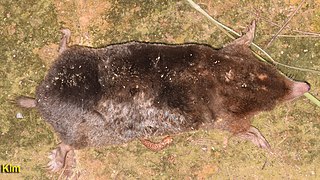
Coffea canephora is a species of coffee that has its origins in central and western sub-Saharan Africa. It is a species of flowering plant in the family Rubiaceae. Though widely known as Coffea robusta, the plant is scientifically identified as Coffea canephora, which has two main varieties, robusta and nganda.

Washingtonia robusta, the Mexican fan palm or Mexican washingtonia, is a palm tree native to western Sonora and Baja California Sur in northwestern Mexico. It is reportedly naturalized in Florida, California, Hawaii, Texas, parts of the Canary Islands, France, Italy, Israel, Lebanon, Qatar, Spain, and Réunion.

Grevillea robusta, commonly known as the southern silky oak, silk oak or silky oak, silver oak or Australian silver oak, is a flowering plant in the family Proteaceae. It is a tree, the largest species in its genus but is not closely related to the true oaks, Quercus. It is a native of eastern coastal Australia, growing in riverine, subtropical and dry rainforest environments.

The large mole or Ussuri mole, is a species of mammal in the family Talpidae. It is found in China, North Korea, South Korea, and Russia and lives in a long burrow, seldom emerging on the surface of the ground during the day.

ROBUSTA is a nano-satellite scientific experiment developed by the University of Montpellier students as part of a Centre National d'Études Spatiales (CNES) call for student projects in the field of orbital systems.

The Philippine dawn bat is a species of megabat in the family Pteropodidae found in the Philippines.

Shorea robusta seed oil is an edible oil extracted from the seeds of Shorea robusta. Shorea robusta is known as the Sal tree in India. Sal is indigenous to India and occurs in two main regions separated by the Gangetic Plain, namely the northern and central Indian regions. The plant belongs to the Dipterocarpaceae botanical family.

Falsomesosella is a genus of longhorn beetles of the subfamily Lamiinae, containing the following species:

ROBUSTA-1B is a nano-satellite (Cubesat) scientific experiment developed by the University of Montpellier students, a successor to the ROBUSTA satellite, which was launched in February 2012 and lost soon after.
Triunia robusta, or glossy spice bush, is a shrub of the family Proteaceae native to Queensland.
Falsomesosella affinis is a species of beetle in the family Cerambycidae. It was described by Stephan von Breuning in 1938.
Falsomesosella bifasciata is a species of beetle in the family Cerambycidae. It was described by Stephan von Breuning in 1938.
Falsomesosella densepunctata is a species of beetle in the family Cerambycidae. It was described by Stephan von Breuning in 1968, originally under the genus Gyarancita. It is known from Laos.
Falsomesosella mediofasciata is a species of beetle in the family Cerambycidae. It was described by Stephan von Breuning in 1968.
Falsomesosella unicolor is a species of beetle in the family Cerambycidae. It was described by Stephan von Breuning in 1969.
Falsomesosella albofasciata is a species of beetle in the family Cerambycidae. It was described by Maurice Pic in 1925.
Falsomesosella nigronotata is a species of beetle in the family Cerambycidae. It was described by Maurice Pic in 1930.
Falsomesosella grisella is a species of beetle in the family Cerambycidae. It was described by White in 1858. It is known from Taiwan.
Falsomesosella horishana is a species of beetle in the family Cerambycidae. It was described by Gressitt in 1938.
Kahawa Sūg, also known as Sulu coffee or Sulu robusta, is a single-origin coffee varietal grown by the Tausug people of the Sulu Archipelago, Philippines. It is a robusta cultivar, belonging to the species Coffea canephora. It originates from robusta plants introduced to Sulu in the 1860s. It is an important part of traditional Tausug culture. It is mostly consumed locally, though it has started being exported more widely in recent years. It is currently endangered by the introduction of modern higher yield coffee varieties.








